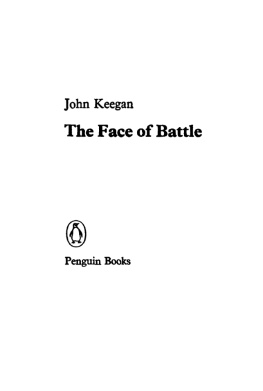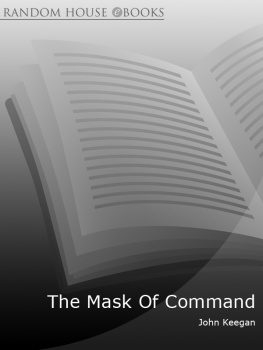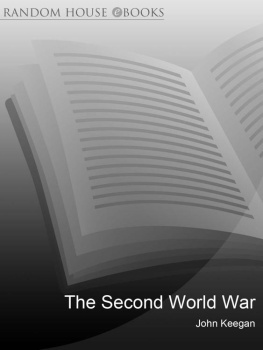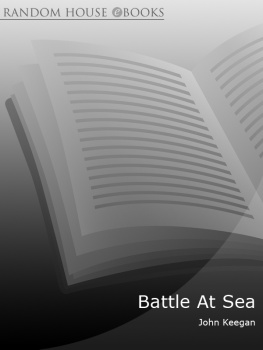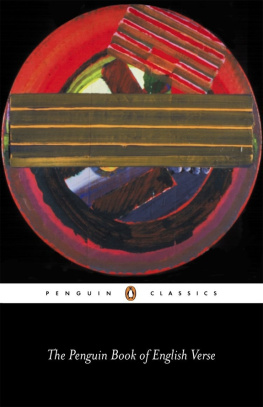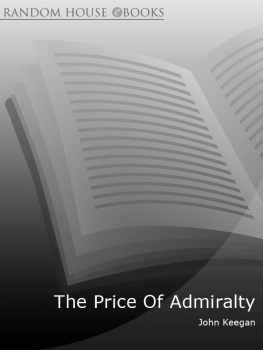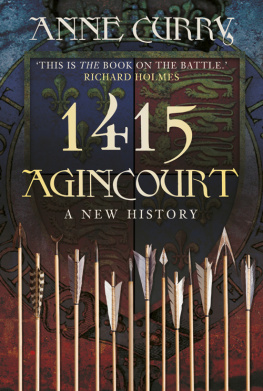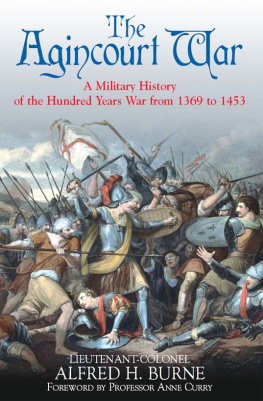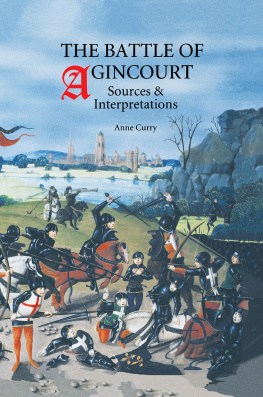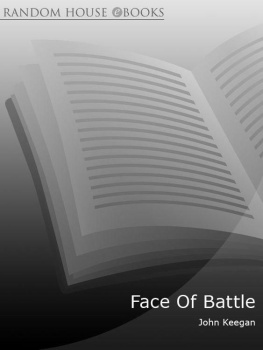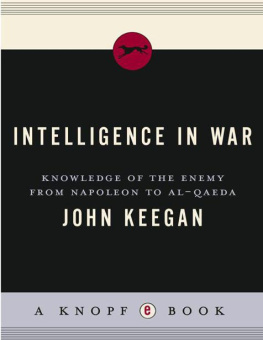John Keegan was for many years Senior Lecturer at the Royal Military Academy at Sandhurst. He is the author of many books on military history, including The Book of War, The Mask of Command, The Price of Admiralty, The First World War, The Second World War, and A History of Warfare. He is a Fellow of the Royal Society of Literature.
John Keegan
The Face of Battle

Penguin Books
PENGUIN BOOKS
Published by the Penguin Group
Penguin Group (USA) Inc., 375 Hudson Street, New York, New York 10014, U.S.A.
Penguin Group (Canada), 90 Eglinton Avenue East, Suite 700, Toronto, Ontario, Canada M4P 2Y3 (a division of Pearson Penguin Canada Inc.)
Penguin Books Ltd, 80 Strand, London WC2R 0RL, England
Penguin Ireland, 25 St Stephens Green, Dublin 2, Ireland (a division of Penguin Books Ltd)
Penguin Group (Australia), 250 Camberwell Road, Camberwell, Victoria 3124, Australia (a division of Pearson Australia Group Pty Ltd)
Penguin Books India Pvt Ltd, 11 Community Centre, Panchsheel Park, New Delhi - 110 017, India
Penguin Group (NZ), 67 Apollo Drive, Rosedale, North Shore 0632, New Zealand (a division of Pearson New Zealand Ltd)
Penguin Books (South Africa) (Pty) Ltd, 24 Sturdee Avenue, Rosebank, Johannesburg 2196, South Africa
Penguin Books Ltd, Registered Offices: 80 Strand, London WC2R 0RL, England
First published in Great Britain by Jonathan Cape Ltd 1976
First published in the United States of America by The Viking Press 1976
Published in Penguin Books 1978
50 49 48
Copyright John Keegan, 1976
All rights reserved
ISBN: 978-1-4406-7399-3
Acknowledgement is made for material reprinted
by permission of Faber and Faber Limited
from If Germany Attacks by G. C. Wynne
Printed in the United States of America
Set in Monotype Plantin
Except in the United States of America, this book is sold subject to the condition that it shall not, by way of trade or otherwise, be lent, resold, hired out, or otherwise circulated without the publishers prior consent in any form of binding or cover other than that in which it is published and without a similar condition including this condition being imposed on the subsequent purchaser.
The scanning, uploading and distribution of this book via the Internet or via any other means without the permission of the publisher is illegal and punishable by law. Please purchase only authorized electronic editions, and do not participate in or encourage electronic piracy of copyrighted materials. Your support of the authors rights is appreciated.
Version_5
In memory of my father and my father-in-law
List of Illustrations
between pages 192 and 193
List of Maps
Acknowledgements
This book has been written chiefly from printed sources, some of which are listed in the bibliography. But I have also derived much information and many ideas from colleagues, pupils and friends (it is one of the pleasures of teaching at Sandhurst that these categories overlap), in particular from the following serving or retired soldiers: Brigadier Peter Young, D.S.O., M.C., Brigadier D. W. V. P. OFlaherty, D.S.O., Major-General A. H. Farrar-Hockley, D.S.O., M.B.E., M.C., Colonel E. M. P. Hardy, Lieutenant-Colonel Michael Barclay, Royal Scots Dragoon Guards, Lieutenant-Colonel Jeremy Reilly, D.S.O., Royal Regiment of Fusiliers, Major Charles Messenger, Royal Tank Regiment, Major Michael Dewar, Royal Green Jackets, Captain Terence Johnston, Coldstream Guards, Lieutenant Timothy Weeks, Light Infantry, and Lieutenant Hugh Willing, Royal Green Jackets; from the following members of the Sandhurst academic staff: Dr Christopher Duffy, Dr Richard Holmes, Dr Gwynne Dyer, Dr John Sweetman, Mr David Chandler, Mr Peter Vigor and Mr William McElwee; from our homologues at the cole spciale militaire de St-Cyr, Lieutenant-Colonel Michel Camus, Lgion trangre, and Commandant Marc Neuville, Chasseurs pied; from Major-General Alastair Maclennan, O.B.E., of the Royal Army Medical College, Mr A. S. Till, F.R.C.S., of the United Oxford Hospitals, Dr John Cule, Dr H. Bleckwenn of Osnabruck and Dr. T. F. Everett, my father-in-law, who died before this book was finished; from Dr M. Haisman and Dr M. Allnut of the Army Personnel Research Establishment; from Mr Michael Howard, Professor Richard Cobb, Professor Geoffrey Best, Mr Harmut Pogge von Strandmann and Brigadier Shelford Bidwell. I also corresponded fruitfully with Professor Bernard Bergonzi and Dr C. T.
Allmand. Brigadier Young, Mr Howard and Mr Chandler were kind enough to give permission for extracts from their books to be used for purposes which do not do justice to their quality. I owe special debts of gratitude to Mr Barrie Pitt and Mr Derek Anyan. Mr Anthony Sheil, Mr Alan Williams and Mr David Machin have been unfailingly encouraging; I hope I have not disappointed them. It is a pleasure to thank Lieutenant-Colonel Alan Shepperd, M.B.E., the Librarian (and creator) of the Central Library, R.M.A. Sandhurst, and his friendly, helpful and efficient staff for all their help; Mr R. W. Meadows is particularly to be thanked for procuring books through the inter-library loan service. I am also grateful to Mr Kenneth White, of the Staff College Library, and to the staff of the London Library. Mrs Valerie Horsfield typed much of the manuscript and has my thanks. My wife Susanne would have typed it all, had I not insisted that her hands were already overfull with her own writing and the care of four children; and were the title and subject of this book not so inappropriate, I would have dedicated it to her, for all she has done.
JOHN KEEGAN
Royal Military Academy, Sandhurst
10 December 1974
1 Old, Unhappy, Far-off Things
A Little Learning
I have not been in a battle; not near one, nor heard one from afar, nor seen the aftermath. I have questioned people who have been in battlemy father and father-in-law among them; have walked over battlefields, here in England, in Belgium, in France and in America; have often turned up small relics of the fightinga slab of German 5.9 howitzer shell on the roadside by Polygon Wood at Ypres, a rusted anti-tank projectile in the orchard hedge at Gavrus in Normandy, left there in June 1944 by some highlander of the 2nd Argyll and Sutherlands; and have sometimes brought my more portable finds home with me (a Mini bullet from Shiloh and a shrapnel ball from Hill 60 lie among the cotton-reels in a painted papier-mch box on my drawing-room mantelpiece). I have read about battles, of course, have talked about battles, have been lectured about battles and, in the last four or five years, have watched battles in progress, or apparently in progress, on the television screen. I have seen a good deal of other, earlier battles of this century on newsreel, some of them convincingly authentic, as well as much dramatized feature film and countless static images of battle: photographs and paintings and sculpture of a varying degree of realism. But I have never been in a battle. And I grow increasingly convinced that I have very little idea of what a battle can be like.
Neither of these statements and none of this experience is in the least remarkable. For very, very few Europeans of my generationI was born in 1934have learned at first hand that knowledge of battle which marked the lives of millions of their fathers and grandfathers. Indeed, apart from the four or five thousand Frenchmen who, with their German, Spanish and Slav comrades of the Foreign Legion, survived Dien Bien Phu, and the slightly larger contingents of Britons who took part in the campaign in central Korea in 195051, I cannot identify any group of people, under forty, in the Old World, who have been through a battle as combatants. My use of the words battle and combatants will indicate that I am making some fairly careful exceptions to this generalization, most obviously in the case of all those continental Europeans who were children during the Second World War and over whose homes the tide of battle flowed, often more than once, between 1939 and 1945; but also in the case of the thousands of British and French soldiers who carried arms in Africa and South-East Asia during the era of decolonization, to whose number I ought to add the Portuguese conscripts still campaigning in Mozambique and Angola, and the British regulars policing the cities and countryside of Ulster.

